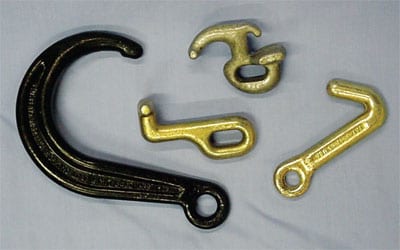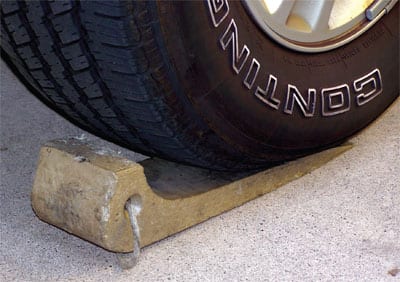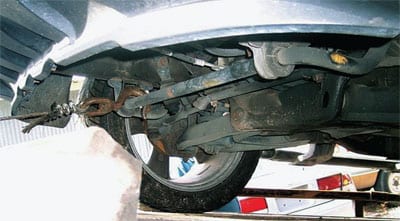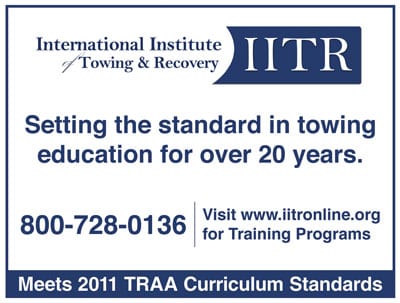CARRIER LOADING TIPS

While towing equipment manufacturers offer several styles of carrier beds for low clearance vehicles, a good operator needs to have a variety of tools available to make the job easier and safer. With sling tow trucks, all you needed to get the job done was a set of towing chains and a couple of 4x4s. With wheel-lifts it was even easier. Then came carriers, and the need for a lot more equipment to safely load and transport vehicles. While often touted as the damage-proof way to tow or transport vehicles, a carrier in the hands of an inexperienced operator, or a poorly equipped carrier, is more likely to damage vehicles than any other piece of towing equipment.

To perform properly, tire skates should be installed as far under the tire as possible.
Securing Hooks
When it comes to carrier loading or securement devices, there is no one “right” hook to use. A carrier can be equipped with J hooks, mini-J hooks, T hooks, R hooks, S hooks, eye bolts and nylon straps for securing vehicles. Use the proper device recommended by the vehicle manufacturer and remember that not every hole or slot on a vehicle is intended to be a hook-up or securement point. Look for reinforcement, or a hole with a rolled or beveled edge, as an attachment point. T or R hooks should be used only in reinforced, slotted holes in the vehicle frame with the hook seated at a 90-degree angle. The same is true when using tie-down hooks. As an example, a mini-J hook is often used as a hook on a loading bridle. Using it as a securement hook in any round frame hole is not always advisable. Used as a rear securement device, after a panic stop, you may discover why it is also known as a “can opener.”
Loading Bridles
When attaching a loading bridle to the front end of a vehicle, always go for the inboard side near the frame or engine. Most carrier tie-down points (and the safest) are usually located in the engine cradle area or in the torque box area of a vehicle frame – just behind the front wheels and in front of the rear wheels. You can always refer to the AAA Towing and Service Manual for the proper attachment points. The AAA manual provides towing information and tie-down locations, as well as service information for domestic and foreign vehicles. Use nylon straps to prevent damage to alloy or fragile suspension components. Many manufacturers now recommend the use of nylon straps around the vehicle’s tires to prevent this type of damage.
Ramping
A carrier should be equipped with several types of ramping materials to accommodate low clearance vehicles. As for wood blocking, 4x4s and 2x10s are popular sizes of ramping materials. Trim the ends of the lumber to an angle so tires will roll easily onto the ramping. Setting the bed down on the wood will hold the ramping in place during loading. Using a 4×4 and/or spacer blocks on top of the loading bridle will create more clearance between the bridle and the air dam or valance. Thick-wall PVC pipe has also been used, but is hard to secure and tends to move around more than wood blocking. After the vehicle is loaded, always check that there is adequate clearance between the winch line hook, the loading bridle and the vehicle undercarriage, particularly on vehicles with aluminum oil pans.
Vehicles That Don’t Roll
If you encounter a vehicle with wheels that don’t roll, placing a small block of wood in front of the tires will cause the tires to ride up, reducing resistance. Even better are “carrier skates” or tapered pieces of wood that can be used for loading vehicles that do not roll or have locked wheels. Skates work best when they are under tires. Skates can also be used as a ramping device by flipping them over against the edge of the carrier bed when using a motorcycle dolly or GoJaks for loading. If wheels are missing, there are blocks available that fit under the brake rotor or control arm. Another method to reduce rolling resistance is to lubricate the bed in front of the tires. At some point almost every type of liquid has been tried, from oil to laundry soap to products like WD-40. All of these may solve the immediate problem but will leave a residue that could cause you to slip and fall. A better choice is plain water or window cleaner, which evaporates without leaving slippery residue.
Preventing Back Rolls
Using a short tether (chain or strap) will prevent a vehicle from rolling backward if the winch or winch line fails. Secure a short chain or strap to the carrier bed and, as you are loading, attach it to the vehicle. If the winch line should fail, the vehicle can only roll to the end of the tether strap, and not down the road or across a dealer’s service shop.

Wrong way: There is a high potential for damage to the underside and valance of this BMW because the winch line hook is attached directly to the sway bar. Also, the use of cable clips is not acceptable and may not be approved in many states.
Winch Speed
While loading, set the winch speed at idle or slightly above. Setting the speed higher may increase the winch line speed, but can damage the winch, carrier bed or the vehicle you are loading.
Securing the Vehicle
Always secure the vehicle with a four-point tie down. Do not use the winch to tighten chains or to make the vehicle “hunker down a bit so it won’t move.” This can cause significant damage to the vehicle you are transporting and/or your equipment. After the vehicle is secured properly, back off the winch line slightly so you are not shockloading the wire rope while in tow.
 The International Institute of Towing and Recovery (IITR) is a non-profit organization with a mission to serve as a source of education and to otherwise support the towing industry in the development of tow truck operator training, and to work with those in the educational field in developing programs for the specific purpose of furthering educational opportunities of those in the towing and recovery business. Visit www.iitronline.org. Peter Fuerst is chairman of the Board of the IITR, and a 1995 inductee into the International Towing and Recovery Hall of Fame.
The International Institute of Towing and Recovery (IITR) is a non-profit organization with a mission to serve as a source of education and to otherwise support the towing industry in the development of tow truck operator training, and to work with those in the educational field in developing programs for the specific purpose of furthering educational opportunities of those in the towing and recovery business. Visit www.iitronline.org. Peter Fuerst is chairman of the Board of the IITR, and a 1995 inductee into the International Towing and Recovery Hall of Fame.